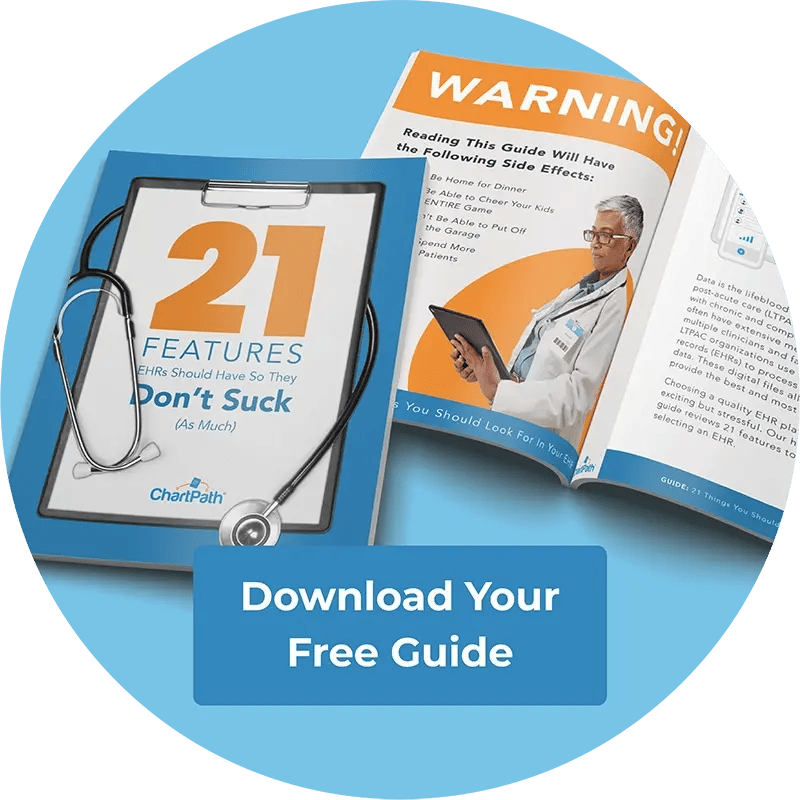RCM Management in LTPAC: Strategies to Streamline Billing and Boost Cash Flow

Today's healthcare organizations are tasked with delivering quality patient care while simultaneously ensuring profitability. Collaborating with clinicians to provide value-based care and foster positive patient health outcomes is one challenge — doing so while accurately billing for all services and minimizing claims delays or denials is quite another.
Revenue cycle management (RCM) seeks to unify care delivery and administrative processes so that organizations can be fully reimbursed for their services as quickly as possible. Let's look at how effective RCM management can benefit your healthcare processes and what steps you can take to streamline your RCM workflows.
We'll also survey the key challenges poor management can pose to your operations and the best practices that can overcome them, and how RCM management solutions like ChartPath can help.
What Is Revenue Cycle Management (RCM)?
RCM refers to the full scope of processes for ensuring complete and timely payment for all the services that healthcare organizations render to their patients. From gathering a patient's insurance information to reporting on the efficiency of your operations, a healthcare organization's RCM processes can consist of many phases, so keeping track of them all can be a challenge.
Efficient RCM management is especially important for long-term post-acute care (LTPAC) facilities. Resources may be limited in these facilities, and complete, timely payment can be essential for continuing operations.
LTPAC units may have an RCM manager to oversee their revenue processes and find ways to streamline their financial workflows. But they ultimately need an interoperable tool that links their documentation and RCM workflows to implement their strategies effectively. EHR solutions like ChartPath come equipped with many RCM functionalities, allowing RCM managers in LTPAC facilities to analyze their revenue data with ease.
Challenges of RCM in Post-Acute Care
Healthcare organizations face many challenges in their efforts to obtain prompt, complete payment for their medical services. These hurdles can impact not only their profitability but also their ability to deliver quality care to the patient.
The most common RCM management obstacles for LTPAC facilities are:
-
Complex payer requirements, which make it difficult to know what criteria must be satisfied for facilities to obtain payment
-
High denial rates due to coding or billing errors
-
Delayed reimbursements, which lengthen the RCM lifecycle
-
Greater administrative burdens, a major cause of clinician burnout
RCM-related difficulties can also hinder your team's productivity. Surveys show healthcare clinicians devote an average 8.8 hours per week on documentation, including RCM workflows such as submitting patient health data.
When organizations reduce the amount of time that clinicians must spend on such tedious tasks, they free them up to deliver higher-quality care to their patients. This results in superior patient health outcomes and an improved patient experience, all while boosting your profitability.
Core Components of Effective RCM Management
RCM management consists of multiple stages, all of which depend on a series of core components to carry them out efficiently:
1. Preregistration to collect a patient’s demographic and insurance information before the encounter occurs
2. Patient registration, where clinicians gather additional patient health information (PHI), such as personal details and medical history
3. Insurance verification and authorization to validate insurance coverage and all prior authorizations
4. Charge capture and coding, translating all services and procedures performed into standardized billing and ICD-10 codes. Tools that fail to correct coding errors are one of the top ways practices lose money with the wrong EHR, so leveraging an EHR tool with code-checking functionalities is especially beneficial at this stage.
5. Claim submission of all coded claims to the proper payer, who will decide whether to pay in full, in part, or deny the claim altogether
6. Denial management, where billing personnel manage and appeal any denied insurance claims
7. Payment posting, which places any remaining balances on the patient's account through their patient portal
8. Patient billing for any expenses that insurance didn’t cover, including co-payments, deductibles, or charges for non-covered services
9. Collections, where billing personnel follow up on unpaid balances by sending reminder bills, setting up payment plans, or referring delinquent payers to collections.
10. Reporting, where teams analyze their revenue data according to their key performance indicators (KPIs) and report on the health of their revenue cycle, helping identify any opportunities for improvement
With so many components at play, having the right RCM health information management tool is a must. Platforms such as ChartPath feature advanced charge capture applications that let you identify, document, and code all services rendered, helping you create more accurate claims. The result is fewer errors, better communication with payers, and a streamlined RCM pipeline that lightens the load for your healthcare team.
Measuring the Impact of Strong RCM Management
Key performance indicators (KPIs) help you assess the success of your RCM processes. Tracking them can yield insights into which processes are working, along with opportunities for growth. A few RCM KPIs to monitor are:
-
Clean claim rate: the number of successfully submitted claims
-
Denial rate: the percentage of claims over a given period that payers have denied
-
Days in accounts receivable (A/R): the amount of time it takes to get paid
-
Gross collection rate: the percentage of payment received relative to the amount charged — 95% or over is usually considered ideal
-
Net collection rate: the percentage of payment received relative to the amount that insurance companies are contractually required to pay
As part of their RCM functionalities, the leading EHR tools let you monitor and analyze these and other KPIs. That way, you can track the health of your patients and your profits at the same time — and all with one interoperable tool.
How ChartPath Supports RCM Management in LTPAC
ChartPath has been delivering EHR solutions with RCM functionalities for LTPAC facilities since 2012. From built-in billing tools to automate tedious administrative workflows to coding support features that improve your claims accuracy, ChartPath not only empowers clinicians to deliver superior patient care but also allows administrators to maximize their healthcare organizations' profitability at the same time.
These tools can reduce administrative strain across your RCM pipeline, accelerate payment cycles by ensuring accurate billing and coding, and even increase reimbursement rates by accurately capturing the full scope of services that you've provided.
Ready to see how ChartPath can elevate your RCM management processes? Schedule your demo today.
Get Awesome Content Delivered Straight to Your Inbox!
Posts by topic
- EHR
- Better Charting
- LTPAC
- AI
- RCM
- Compliance
- Healthcare Trends
- Press Release
- GUIDE
- reporting
- Artificial Intelligence
- Assisted Living
- Automation
- Behavioral Health
- Business
- Events
- General
- MIPS
- Operations
- Patient Outcomes
- Physician Billing Services
- Population Health Management
- Resumption of Care
- SNF
- TCM
- Value Based Care
- eCR
- interoperability
- partners
- regulations
- regulatory See All See Less




